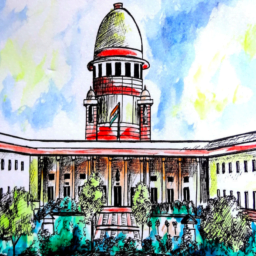INTRODUCTION
The Latin phrase “Nil Novi Spectrum” perfectly reflects India’s juvenile justice system. It can be described as ‘nothing new on this planet,’ and among Indians, particularly in northern India, there is a saying whose English translation is “It is Never Too Late to Mend,” which can represent India’s current juvenile justice system. However, instead of using these sayings, the appropriate statement suited to be the foundation for India’s juvenile justice system is “Old enough to do the crime, old enough to do the time,” which is an English concept used by some of the states in the USA. This concept of leniency has existed since ancient India because there was an idea that juveniles should be treated favorably since there is a school of thought that says– Youth have a tendency for expressing profound and persistent anger, which is typically followed by violent approaches.
In today’s world, juvenile crime is a big problem. This is a critical issue since, according to the population composition, the youth in the age bracket of 15-19 account for approximately 100,215,890 people, or 9.7% of the entire population of India[1]. It affects not just the generations, but the entire family as well as the entire neighbourhood.
The percentage of crimes committed by minors aged 15-16 has climbed considerably during the last few decades.[2]. Formative year events, dominating virility, upbringing, economic deprivation, backwardness, and other variables may all contribute to the psyche behind the wrongdoing in the crime. Children aged 6 to 10 are an easy tool for carrying out unlawful or criminal activities. Because children’s minds have a naive and manipulative nature, they can be enticed for a little cost. The dreadful incident of the Nirbhaya Gang Rape Case[3], in which an accused was just six months away from turning 18, the age of becoming a major, forced the Indian legal system to convict him as a juvenile instead of a full-fledged offender, sparked a major debate and discussion about the juvenile justice system. Juvenile participation in such an outrageous crime motivated the Indian Parliament to adopt the “Juvenile Justice (Care and Protection) Act, 2015.” However, before looking deep into the said act and other juvenile-related provisions in the Indian legal system, let us first define juveniles and how they differ from “children” in the Indian context.
THE DIFFERENCE BETWEEN A CHILD AND A JUVENILE
According to section 2(e) of the Children Act, 1960, which was in effect from 1960 to 1986[4], a “child” is defined as a boy or a girl who has not yet reached the age of sixteen or eighteen years. A “child” is defined in subsection 12 of Section 2 of The Juvenile (Care and Protection) Act, 2015 as any person under the age of eighteen. The term “child” is divided into two categories by the Act: –
– a child who conflicts with the law
– a child in need of protection and care
A child who has committed an offence and was under the age of eighteen at the time of the offence is classified as “a child in conflict with the law,” while the second category is “a child in need of care and protection,” which includes any child who is not facing any charges as defined in Section 14 of the Act.[5]
Although a child and a juvenile are nearly identical, there are some differences in their implications and circumstances that distinguish them. Although a child is simply seen as an innocent individual, the term “juvenile” has a negative legal connotation. Juvenile denotes immaturity or a young criminal, while child denotes youth and naiveté. In simple terms, if a youngster is charged with a crime, he is referred to as a juvenile.
INDIA’S JUVENILE JUSTICE SYSTEM
Before the eighteenth century, juvenile offenders were handled in the same manner as other criminal offenders. Around the mid-eighteenth century, a push for a particular treatment of juvenile offenders began. The Indian Juvenile Justice Policy is developed around the Constitution. Articles 15 (3), 21, 24, 39 (e) and (f), 45 and 47 of the constitution, plus various international Covenants, including the UN Convention on the Rights of the Child (CRC) as well as the UN Standard Minimum Rules for Juvenile Justice Administration (Beijing Rules). The United Nations General Assembly passed the Convention on the Rights of the Child on November 20, 1989, which includes provisions to safeguard the right of juvenile offenders. The convention also protects the social disintegration of juveniles by stating that no judicial actions or court trials would be held against juveniles. The Indian Parliament was compelled by this convention to annul the Juvenile Justice Act of 1986 and substitute it with the Juvenile Justice (Care and Protection of Children) Act of 2000, which is more reformed and significantly better. In addition, the Juvenile Justice Act of 1986 came into effect, replacing the previous Children Act of 1960 in order to adopt the United Nations General Assembly’s Standard Minimum Rules for the Administration of Juvenile Justice, which were passed in November 1985. Excluding Jammu and Kashmir, the law established a national foundation for the protection of the rights and interests of juveniles. It even covered some fundamental needs for the administration of justice as well as the course of action to be taken when juvenile offenders commit heinous offences.
The Juvenile Justice Act of 2000 was passed to join the United Nations General Assembly’s 1989 convention on the protection of children’s rights, but it was badly implemented and supplied. It was modified again in 2006 and 2011, although both times it was ineffective in closing the gaps and flaws. To counter the development of juvenile delinquency in India, the legislation was repealed and replaced with The Juvenile Justice (Care and Protection) Act, 2015, which is currently the principal statute controlling India’s juvenile justice system.
The “claim of juvenility,” which refers to deciding who may demand the rights of a juvenile or who can be deemed a juvenile, is the first and most controversial matter within the legal community. In India, the Juvenile Justice Board must rule on a claim of juvenility in accordance with Rule 12 of the Juvenile Justice Rules, 2007. The board must determine the claim of juvenility before the court proceedings begin, however, the claim may be raised at any point, even after the case has been decided. The Court concluded in the case of Kulai Ibrahim v. State of Coimbatore[6] that under Section 9 of the Juvenile Justice Act of 2015, an accused has the right to file a claim of juvenility at any point throughout the trial or even after the issue has been resolved. The Supreme Court ruled in Deoki Nandan Dayma v. State of Uttar Pradesh[7] that a pupil’s date of birth stated in school records is acceptable evidence for determining a juvenile’s age.
India has established a law that addresses juvenile offenders’ rights, interests, and safety. This is an attempt to address the issues linked with juvenile delinquency. The three pillars of India’s juvenile justice system are as follows: The three pillars of India’s juvenile justice system are as follows:
- Young offenders should not be prosecuted in courts; instead, they should be given the best possible rehabilitation.
- Instead of being punished by the courts, they should be offered reformative reforms.
- A child in violation of the law should receive non-punitive care while on trial[8], based on the community’s social control agencies, such as Observation Homes[9] and Special Homes[10].
CONCLUSION
A crime is not only a wrong that is outlawed by law. It’s a mistake that academics have labelled as morally reprehensible, with consequences that extend far beyond the sufferer. That is why crime is regarded as a crime against the state. As we approach modern times, the concept of crime is changing. The concept of juvenile delinquency is relatively new, and it is highly controversial. Although the government is attempting to reduce juvenile criminality by establishing various laws, these are insufficient. The current laws have failed to generate a deterrence in the minds of juveniles, resulting in ineffective effects. It is critical to note that when hearing a case, the circumstances of the case, as well as the type of the act committed, should be utilized as parameters to determine whether or not the so-called juvenile was capable of understanding his actions. Furthermore, the concept of heinous crimes needs to be revisited. Simply setting a punishment threshold in terms of years does not reflect the criminal’s thoughts or convey the victim’s grief.
Author(s) Name: Arghya Sen (Amity University, Kolkata)
References:
[1] Office of the Registrar General & Census Commissioner, India, Retrieved from: https://censusindia.gov.in/.
[2] Crimes in India 2020. National Crime Records Bureau. (n.d.). Retrieved December 2, 2021, from https://ncrb.gov.in/en/Crime-in-India-2020.
[3] Mukesh v. State (NCT of Delhi) [(2017) 6 SCC 1]
[4] The juvenile justice Act, 1989, retrieved from https://thefactfactor.com/facts/law/legal_concepts/criminology/the-juvenile-justice-act/12079/.
[5] The Juvenile Justice (Care and Protection of Children) Act, 2015.section 2
[6] Kulai Ibrahim v. State Rep. by the Inspector of Police B-1, Bazaar Police Station, Coimbatore [2014] (142) AIC 144
[7] Deokinandan And Ors. vs State Of U.P. And Ors. [1995] 1996 CriLJ 61
[8] Juvenile Justice (Care and Protection) Act, 2015. Section 2 (13)
[9] Juvenile Justice (Care and Protection) Act, 2015 Section 47
[10]Juvenile Justice (Care and Protection) Act, 2015. Section 48















